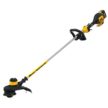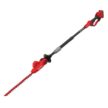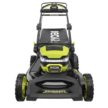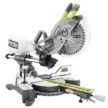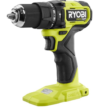RYOBI 15 inch String Trimmer
RYOBI ONE+ HP 18V Brushless 15 inch Attachment Capable String Trimmer
The RYOBI ONE+ HP 18V Brushless 15 inch Attachment Capable String Trimmer (model P20220) is one of the new tools that RYOBI introduced this spring. It’s part of RYOBI’s EXPAND-IT power pole attachment family, in which a powered handle segment attaches to a lower tool attachment. The string trimmer is one of these attachments, but pole saws, blowers, edgers, and several other tool attachments are also available. One powered handle/base-unit and a collection of attachable extended tools – that’s efficient and cost-effective! Here I’m just looking at the string trimmer configuration though.
From Weed Whacker to string trimmer
I don’t know what homeowners and landscapers did before string trimmers were available. Actually, they had to use hand-operated trimmers which were tedious, inefficient, didn’t work very well and were just a general pain the behind. The first string trimmer was invented in 1971 under the name “Weed Whacker”, and generations of homeowners and landscapers have been forever grateful. It literally changed the way that lawns and landscapes are managed, and the economics of doing it.
RYOBI makes a number of string trimmers, as you’d expect. A few years ago Todd reviewed the RYOBI 18-volt P2002, with which he was quite pleased. I’ve been using the very similar P2005 for about five years now (see below), and I’ve been likewise pretty happy. Both of these (and their sister) models are targeted at homeowners and are about 40-inches long, with the operating handle at the far upper end right next to the battery. My only real complaint about the P2005 was that the string didn’t advance by bump-feed. It used another mechanism that I found didn’t always work reliably for me, necessitating that I advance the line by hand. That only takes about 10 seconds…but hey, I’m a busy guy! <smile>

New brushless string trimmers from RYOBI
Fast forward to 2022, and this spring RYOBI introduced two new string trimmers, both longer and looking more like the models that professional landscapers use. One family is 40-volt based and the other 18-volt based. I opted to try out the 18-volt model on the theory that 40-volts would be way overkill for my needs. And I was right, the 18-volt RYOBI ONE+ HP 18V Brushless 15 inch Attachment Capable String Trimmer has a lot of power, more that I actually need, and certainly way more than my old P2005.
Now, I’m not a professional landscaper, so I speak only as a homeowner here. I like banging nails, not playing in the dirt. Nonetheless, my string trimmer is one tool that comes out and gets used on a regular basis from spring to fall. In this look at the RYOBI ONE+ HP 18V Brushless 15 inch Attachment Capable String Trimmer I didn’t try to torture test it; I didn’t use it in a two-year overgrown field to see if it could double as a brush hog. I simply used it to trim up after I mowed my lawn, which is exactly the way it was designed to be used, and in fact as it will be used.
RYOBI tools are made exclusively for The Home Depot by TTI (Techtronic Industries Co. Ltd.), which also makes Milwaukee and several other tool brands. RYOBI is marketed by The Home Depot as their entry-level/DIY tool line, and for sure their tools aren’t expected to hold up to the demands of 24/7/365 use. But my experience in engineering tells me that it would be a shock if parts weren’t shared between the TTI brands; economies of scale simply push a manufacturer in that direction. In fact, as I’ve written many times (one example here), I’ve lost count of the number of professional trades people who’ve told me that they use RYOBI tools for many tasks that they do less than all-day/every-day. In fact, that’s how I define the difference between lower-cost brands and higher cost ones: not as a pro/DIY difference, but a duty-cycle difference. And when it comes to landscaping, as a homeowner, I’ve been more than satisfied with my old P2005 string trimmer and RYOBI electric mower.
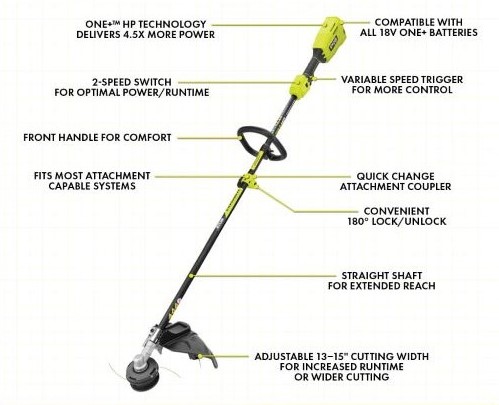
The RYOBI ONE+ HP 18V Brushless 15 inch Attachment Capable String TrimmerSpecs
The RYOBI 18V ONE+ HP 15 inch Attachment Capable String Trimmer kit features:
- Brushless motor
- EXPAND-IT attachment capability
- REEL EASY + bump feed head with speed winder crank for fast and simple reloading is 60-seconds of less
- Variable speed trigger with 2-speed switch
- Compatible with 0.080 inch and 0.095 inch line
- Adjustable 13-inch to 15-inch cutting width
- Includes RYOBI 18V 6.0 Ah battery and 18V charger
- Works with all RYOBI 18V ONE+ batteries
- 3-year warranty
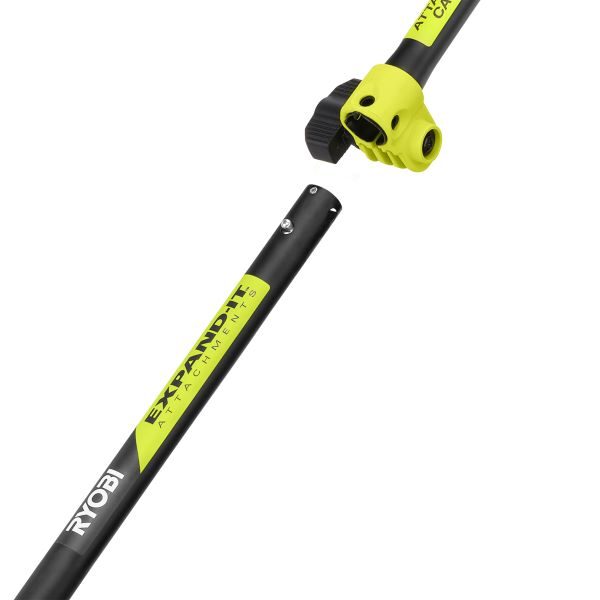
The RYOBI ONE+ HP 18V Brushless 15 inch Attachment Capable String Trimmer In Use
The first thing I noticed with the RYOBI 18V ONE+ HP 15 inch Attachment Capable String Trimmer was the power! This thing screams compared to my older P2005. If you have any tough weeds to trim – forget about regular ol’ grass – this should do the trick. I can only imagine what the 40-volt version is like. It does its intended job very well!
Other than trimming weeds and grass like lightning, the other main thing about a tool like this is its ergonomics. The controls are easy to reach (see below). The variable speed trigger works well but has a bit of a learning curve although I’m not sure why I wouldn’t always have the pedal to the floor (but then I’m not a landscaping pro). The power section connects to the attachment section easily and quickly. Bump feed works as expected.
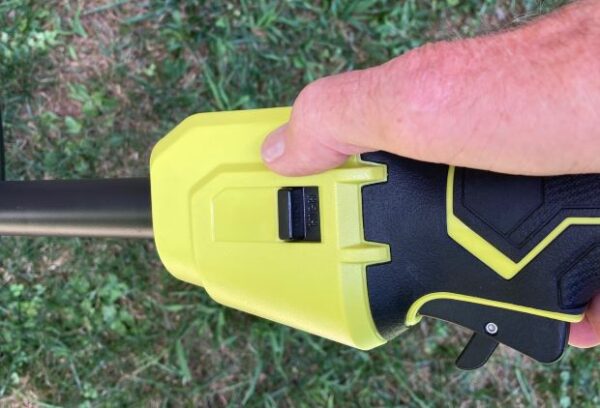
I also noticed some interesting compare/contrast differences with the old P2005, which is a very different design.
First, the OAL of the RYOBI 18V ONE+ HP 15 inch Attachment Capable String Trimmer is 68-inches, and in contrast to the P2005 the head doesn’t angle-adjust. This means that you can attack the grass/weeds at only one angle.
Second, the RYOBI 18V ONE+ HP 15 inch Attachment Capable String Trimmer has an OAL of about 68-inches. The battery is to the rear of the operator’s strong hand (the hand that works the controls) by about 12-inches. The mid-shaft secondary handle is 16-inches from the (center of the) rear hand grip, and the cutting head (the business end) of the tool is 41-inches from the mid-shaft handle.
Thus you can see that the battery constitutes a load that works a lever via the fulcrum at the mid-shaft handle. Because the head angle doesn’t adjust, you have to lift or lower the read handle and its battery weight to get the desired cutting angle. I’m of average height and I had to lift the rear handle several inches to get the right angle. So your rear-hand-side shoulder and neck muscles (the upper traps) wind up lifting and holding in place the weight of the battery for as long as you’re using the tool (you can see this in the manufacturer’s picture below). This isn’t much of a strain for most people, but if you have arthritis in the neck or shoulder it may be an issue. I tried swapping out the 6Ah battery that came with the kit for an older 2Ah battery and did notice a nice difference in weight and potential strain (at the expense of run-time, of course).
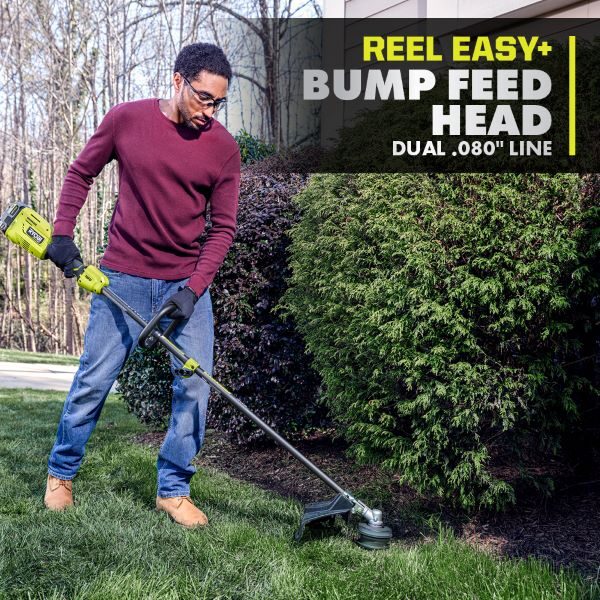
Third, when it came to edge trimming the RYOBI 18V ONE+ HP 15 inch Attachment Capable String Trimmer was a clear winner over the P2005. Canting the tool to the side so that the string could trim edges was easy and intuitive. Not so with the older P2005 where such canting isn’t really practical.
Fourth, the additional length of the RYOBI 18V ONE+ HP 15 inch Attachment Capable String Trimmer is a real advantage for reaching places the older design couldn’t.
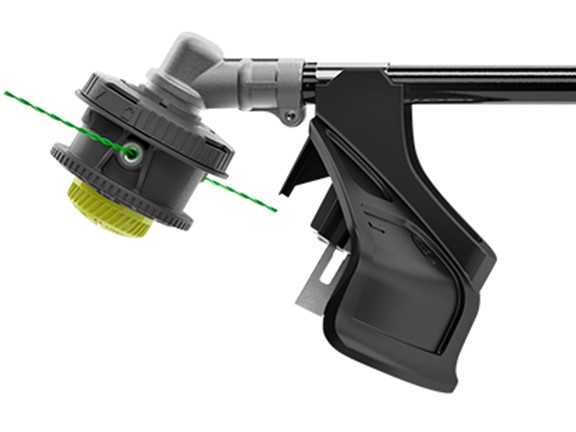
Conclusion/bottom line
All in all, I see the new RYOBI 18V ONE+ HP 15 inch Attachment Capable String Trimmer as a significant improvement over my older RYOBI trimmer. The different physical/ergonomic design does involve a trade-off or two, but on balance, for me, they are worth it. My only suggestion to Big Chartreuse would be to make the head articulating, and then there’d be no trade-offs at all!



